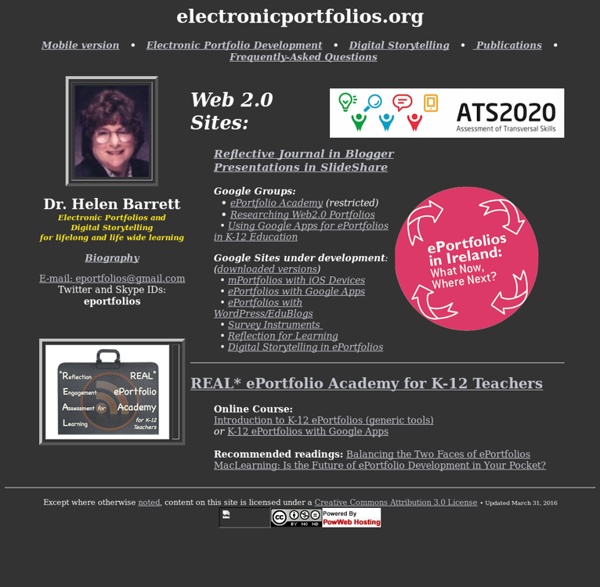



http://electronicportfolios.org/
Salt Lake Community College - It is now a requirement in all General Education courses for students to create an ePortfolio that contains their significant assignments and reflections about those assignments. The ePortfolio also allows students to document their goals and extra-curricular activities as well as to post their resume. Salt Lake Community College's ePortfolio initiative is a great way for students to make sense of General Education and share their learning experiences with friends, family, and scholarship committees. Faculty are also going to want to see your ePortfolio before they write a letter of recommendation for you. As you can see from our navigation pane on the left, we have information about the ePortfolio initiative tailored for students and faculty.
What are e-Portfolios? An e-portfolio is a purposeful aggregation of digital items – ideas, evidence, reflections, feedback etc, which ‘presents’ a selected audience with evidence of a person’s learning and/or ability.Sutherland and Powell (2007) If portfolios are ‘simply a collection of documents relating to a learner’s progress, development and achievements’ (Beetham 2005) then e-portfolios could be defined as simply digital collections of these documents. However, ideas of what an e-portfolio ‘is’ are complex and to an extent the definition and purpose will vary depending on the perspective from which a particular person is approaching the concept. Consensus is beginning to grow as experience of e-portfolios develops which will help converge these different ideas and definitions. Essentially then, an e-portfolio is a product created by learners, a collection of digital artefacts articulating learning (both formal and informal), experiences and achievements.
More on Assessment with Google Docs Video updated at higher resolution. I've had a request to post more about how I use Google Docs to assess my students, so here we go! Remember as a kid, we were always wishing that someone would invent a homework machine? Well if taking stacks of papers home to grade is the teacher's equivalent of homework, then our childhood prayers have finally been answered. Through Google Forms there are now multiple methods to have your computer grade assessments for you - while still maintaining the rich data to inform your instruction! If a picture is worth a thousand words, then a video could be worth exponentially more.
How to Create a Portfolio with Evernote (Education Series) Bio Rob is a teacher at Trillium Charter School in Portland, where he primarily instructs students aged 8-11. He has been working to develop online portfolios with students for the past six years and has taught in private schools, traditional public schools and public charter schools for the past 15 years. I use Evernote, Everywhere: iPhoneiPod TouchiPadMacWindows
The Digital Convergence: Extending the Portfolio Model (EDUCAUSE Review © 2004 Gary Greenberg EDUCAUSE Review, vol. 39, no. 4 (July/August 2004): 28–37. Gary Greenberg Gary Greenberg is Executive Director for IT Teaching and Research Initiatives and Director of the Collaboratory Project, Northwestern University, Evanston, Illinois.
Home of free rubric tools Welcome to iRubric iRubric is a comprehensive rubric development, assessment, and sharing tool. Designed from the ground up, iRubric supports a variety of applications in an easy-to-use package. Best of all, iRubric is free to individual faculty and students. iRubric School-Edition empowers schools with an easy-to-use system for monitoring student learning outcomes and aligning with standards. Click. Middlesex County College : ePortfolio : ePortfolio Contents ePortfolio Contents Here is a guide as to what to write on the seven pages of the ePortfolio. The pages will be developed as part of course assignments. In some cases one or two pages may be left out, as appropriate to the course or individual concerned.
Overview - Welcome to Flubaroo The grades created by Flubaroo will be located in an adjacent worksheet called "Grades", as shown: For each submission, Flubaroo will show which questions were answered correctly ("1" point"), which incorrectly ("0" points), and which were not graded. If less than 60% of students got a question correct, the question will be highlighted in orange to alert you. Additionally, students who scored less than 70% on the assignment will be highlighted in red. The Flubaroo menu will now offer you the ability to email each student their grades, view a summary report, or regrade the assignment.
All Things Google: Using Google for Writing Portfolios Since ProfHacker launched, we’ve written a lot about Google Documents. George, for instance, has written about using it for collaborative work, and we’ve also run posts on using the tool in writing classes, both for work in general and for peer review in particular. For a few years now, I’ve been asking the students in the writing course I teach each fall to do their writing in Google Docs. Portfolio Reflection Organizing the core elements of my professional life as an educator into a single comprehensive document, structured as a professional portfolio, has truly been a growth experience for me. All of the thoughts, ideas, passions, and perspectives were in my head somewhere, but it was both challenging and rewarding to examine them in depth and state them in so many words. The portfolio itself was originally created as part of the Master of Arts in Teaching and Learning program at Nova Southeastern University, which I completed in 2003. Since then, I have continued to grow as a professional educator.